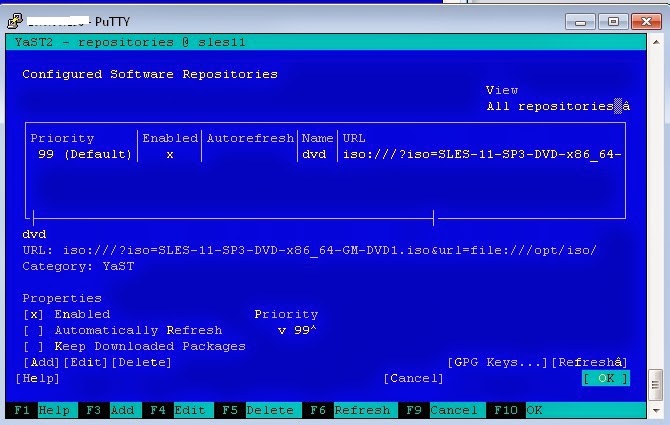In case that you do not have support/online repository for SLES server on Novell here is how you can create local repository from iso file that is located on local file system.
Why do you want to enable local repository? In case that you do not know what term dependency hell means, you should try to install one rpm that is dependent on some another rpm's and probably that another rpm's are dependent on some another rpm's and so on and so on... So from that one rpm package install, you will end up with few hours of searching for dependencies rpm's. That is dependency hell.
To avoid this, you need repository and package manager program. In SUSE like distros that is called zypper and in Red Hat like distors that is called yum. With these you can do all manipulation with packages(install,remove,update,upgrade, info) and best thing is that they know how to resolve dependency issues. That means that from just one line in console you will install all dependencies for packages that you want to install. This will save you a lot of time and lots of nervs!
In case that you do not have experience with SUSE like distributions (SLES or openSuse), they have something called yast2. yast is for yet another setup tool. 2 is for second generation.
yast2 is configuration and management tool(it will be detailed explained in some other post).
First you need to copy iso to your file system.
server1#mkdir /opt/iso
copy iso to this location.
server1#yast2
and that is it!
How to test if this works?
Try to install something. For example try to install wireshark
server1 # zypper install wireshark
Loading repository data...
Reading installed packages...
Resolving package dependencies...
The following NEW packages are going to be installed:
libadns1 wireshark
2 new packages to install.
Overall download size: 12.0 MiB. After the operation, additional 64.1 MiB will be used.
Continue? [y/n/?] (y):
As you can see, libadns1 will be installed because he is dependency for wireshark.
Why do you want to enable local repository? In case that you do not know what term dependency hell means, you should try to install one rpm that is dependent on some another rpm's and probably that another rpm's are dependent on some another rpm's and so on and so on... So from that one rpm package install, you will end up with few hours of searching for dependencies rpm's. That is dependency hell.
To avoid this, you need repository and package manager program. In SUSE like distros that is called zypper and in Red Hat like distors that is called yum. With these you can do all manipulation with packages(install,remove,update,upgrade, info) and best thing is that they know how to resolve dependency issues. That means that from just one line in console you will install all dependencies for packages that you want to install. This will save you a lot of time and lots of nervs!
In case that you do not have experience with SUSE like distributions (SLES or openSuse), they have something called yast2. yast is for yet another setup tool. 2 is for second generation.
yast2 is configuration and management tool(it will be detailed explained in some other post).
First you need to copy iso to your file system.
server1#mkdir /opt/iso
copy iso to this location.
server1#yast2
and that is it!
How to test if this works?
Try to install something. For example try to install wireshark
server1 # zypper install wireshark
Loading repository data...
Reading installed packages...
Resolving package dependencies...
The following NEW packages are going to be installed:
libadns1 wireshark
2 new packages to install.
Overall download size: 12.0 MiB. After the operation, additional 64.1 MiB will be used.
Continue? [y/n/?] (y):
As you can see, libadns1 will be installed because he is dependency for wireshark.







No comments:
Post a Comment